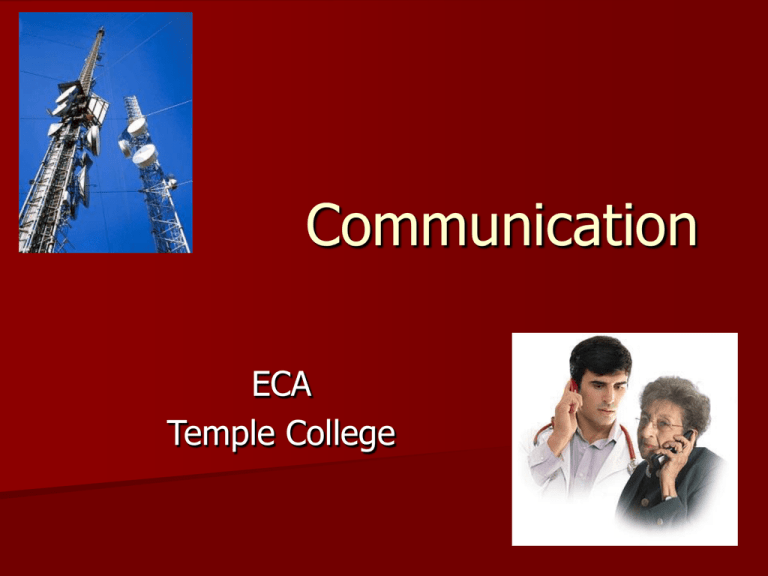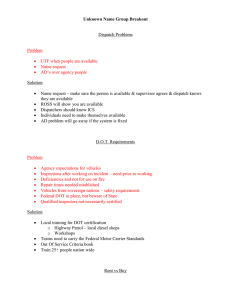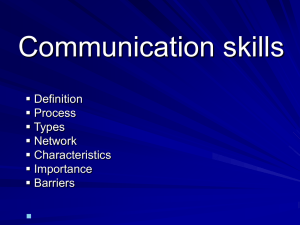Communication ECA Temple College
advertisement

Communication ECA Temple College Sequences of Events Notification of Problem (911) Units Dispatched Units indicate enroute to scene Units indicate on scene – May indication when patient contact occurs Unit indicate enroute to destination Radio report to receiving facility Unit indicate arrival at facility Verbal report to staff Unit indicate back in service Notification of Event 911 – Basic System Universal number for all emergencies – Enhanced Systems Provides Phone number and address to dispatcher – Not all parts of US covered Radio Report – Other Agency radios about problems Individuals walk into Station Dispatch Obtains information Sends appropriate agencies Coordinates response Gives pre-arrival medical direction Manages system resources Notification of Personnel Dispatch Information – Location – Nature of Problem – May receive follow up information giving more specific info Occurs via – Radio – – – – May include paging system Digital Pager Mobile Data Terminal Cellular Phone Telephone Rarely used Verbal report to transporting unit Should be given when crew arrives. Follow same format used for giving a report to the receiving facility Contact Medical Control Via – Radio – Cell phone May include biotelemetry – Transmission of physiological data over radio EKG 12 Lead Communication with Medical Direction Location of Medical Control – Receiving Facility – Not at receiving facility Purpose – Orders for patient care Requires – Organized, Concise and pertinent – AccurateA After receiving an order (or denial of such a request), repeat the order back word for word. Orders that are unclear or appear to be inappropriate should be questioned. Communicating with Receiving Facility Allows hospitals to have the right room, equipment and personnel prepared When communicating with medical direction or the receiving facility, a verbal report should be given. The essential elements of such a report, in the order they should be given, are: – – – – – – – – – – – Identify unit and level of provider (who and what) Patient's age and sex Chief complaint Brief, pertinent history of the present illness Major past illnesses Mental status Baseline vital signs Pertinent findings of the physical exam Emergency medical care given Response to emergency medical care Estimated time of arrival Verbal Report at sites After arrival at the hospital, give a verbal report to the staff. – Introduce the patient by name (if known). – Summarize the information given over the radio: Chief complaint History that was not given previously Additional treatment given en route Additional vital signs taken en route – Give additional information that was collected but not transmitted. Must also leave written report System Components Base Station A radio which is located at a stationary site such as a hospital, mountain top, or public safety agency. Principal transmitter and receiver for system 45 to 275 watt – Set by FCC Multiple channel capabilities Remote Consoles Allows operation of base station from another location Used when it is not convenient to have dispatch center at base station Back up dispatch center Uses dedicated telephone lines to send signal to tower Mobile radios Vehicular mounted device. Mobile transmitters usually transmit at lower power than base stations (typically 20 - 50 watts). Typical transmission range is 10 - 15 miles over average terrain. Multiple Channels May be capable of biotelemetry transmission Portable Radio Handheld device. Typically have power output of 1 - 5 watts, limiting their range. Repeater Receives a transmission from a low-power portable or mobile radio on one frequency and retransmits at a higher power on another frequency. Allows everyone to hear both sides of conversation May be at a fixed site or in mobile unit Other Equipment Digital radio equipment Cellular telephones Faxes Computer Data Terminal Satellite Receivers Radio Frequencies Assigned and licensed by the Federal Communication Commission (FCC). Measured in Hertz – Number of cycles per second – 1 Hz = 1 cycle per second – Modern systems 800 – 900 MegaHertz – Different ranges have different characteristics Geographic features will determine which range is best for your area System Maintenance Equipment is fragile and expensive Avoid mishandling Schedule regular cleaning Repair by qualified technician only Keep batteries charged and spares ready Have Alternatives in case of failure When speaking Ensure radio is on and volume is properly adjusted. Select Correct Channel Listen and ensure it is clear before beginning a transmission. Press the "press to talk" (PTT) button on the radio and wait for one second before speaking. – Allows repeaters and trucking systems to open channel Speak with lips about 2 to 3 inches from the microphone. Address the unit being called, then give the name of the unit (and number if appropriate) where the transmission is originating from. The unit being called will signal that the transmission should start by saying "go ahead" or some other term standard for that area. A response of "stand by" means wait until further notice. When speaking…Do Speak clearly and slowly, in a monotone voice. Keep transmissions brief. If, on occasion, a transmission takes longer than 30 seconds Stop – Pause to see if emergency traffic can use the frequency if necessary. Use plain English (not codes) When Speaking When transmitting a number that might be confused (e.g., a number in the teens), give the number, then give the individual digits. When the transmission is finished, indicate this by saying "over." Get confirmation that the message was received. When speaking…DO NOT Use codes (i.e. 10-4) – May mean different things to different agencies Use meaningless phrases like "Be advised." Use profanity on the air. – FCC may issue fines Use words that are difficult to hear like "yes" and "no." – Use "affirmative" and "negative Give a patient's name or other identifying information over the air. Interpersonal Communication Interpersonal Communication Make and keep eye contact with the patient. Use the patient's proper name, either first or last, depending on the circumstances. Ask the patient what he wishes to be called.. When practical, position yourself at a level lower than the patient. Be aware of your own body language. Speak clearly, slowly and distinctly. Interpersonal Communication Use language the patient can understand. If a patient has difficulty hearing, speak clearly with lips visible. Allow the patient enough time to answer a question before asking the next one. Act and speak in a calm, confident manner Be honest with the patient.



